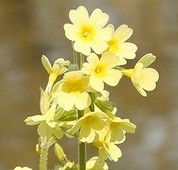Oxlip
(Primula elatior elatior)

Description
Primula elatior elatior, commonly known as the oxlip primrose, is a herbaceous perennial plant native to Europe. It belongs to the Primulaceae family, which is a group of flowering plants that typically grow in cool, moist environments. The oxlip primrose is a popular ornamental plant in gardens and is also used in traditional medicine for its therapeutic properties. Description The oxlip primrose is a clump-forming plant that typically grows to a height of 30-60 cm. Its leaves are rosette-shaped, dark green, and have a wrinkled surface. The leaves are long and oval, with a toothed margin and a pointed tip. The flowers of the oxlip primrose are bell-shaped and have a diameter of about 2-3 cm. The flowers are usually yellow, but can also be pink or white. They grow on a tall, slender stem and are arranged in clusters at the top of the stem. Habitat The oxlip primrose is found in woodlands, meadows, and damp grasslands throughout Europe. It prefers moist, well-drained soil and partial shade. The plant is particularly common in the United Kingdom, where it is native to woodlands and damp meadows. Cultivation The oxlip primrose is an easy plant to grow and is commonly used in gardens as a decorative plant. It prefers partial shade and moist, well-drained soil. It can be propagated by division of clumps in the autumn or spring, or by seed sown in the autumn. Uses The oxlip primrose has been used for centuries in traditional medicine for its therapeutic properties. It is believed to have anti-inflammatory, diuretic, and sedative effects. It has been used to treat a variety of ailments, including respiratory infections, coughs, and rheumatism. The plant has also been used in cosmetics to treat skin irritations and as a natural dye for fabrics. In addition to its medicinal uses, the oxlip primrose is also used as an ornamental plant in gardens. Its bright yellow flowers add color and interest to shady areas, and its early flowering period makes it a popular choice for spring gardens. Conservation The oxlip primrose is a protected species in some areas of Europe, including the United Kingdom. The plant has declined in numbers in some regions due to habitat loss and changes in land management practices. Efforts are underway to conserve the plant through habitat restoration and protection. Conclusion Primula elatior elatior, or the oxlip primrose, is a beautiful and useful plant native to Europe. Its bright yellow flowers add color and interest to shady areas, and its medicinal properties have been used for centuries. As a protected species, efforts are underway to conserve the plant and its habitat for future generations to enjoy. Whether used in traditional medicine or as a decorative plant in gardens, the oxlip primrose is a valuable and important plant species.
Taxonomic tree:







